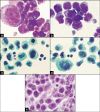Serous fluids and hematolymphoid disorders
- PMID: 35510123
- PMCID: PMC9063582
- DOI: 10.25259/CMAS_02_12_2021
Serous fluids and hematolymphoid disorders
Abstract
Diagnosing hematolymphoid neoplasm by evaluating fine-needle aspiration (FNA) cytology sample is controversial and requires experience and clinical skills. This concept becomes more challenging when evaluating hematolymphoid neoplasm in body fluid. Differentiating between low-grade lymphoma and reactive lymphocytes is often difficult by morphology alone as reactive lymphoid cells may acquire activation morphology from being exposed to different cytokines within the body fluid. However, in most cases there are specific features that may aid in differentiating small reactive from non-reactive lymphocytes including the round shape of the nucleus, the absence of visible nucleoli and the presence of fine clumped chromatin. In large cell lymphoma and leukemia cells involvement of body fluid this concept becomes less challenging. Large cell lymphoma and leukemia cells tend to have large size nuclei, less mature chromatin, and visible nucleoli with and without cytoplasmic vacuoles. However, to reach accurate diagnosis and subclassification, the utilizing of flow cytometry, to confirm monoclonality, and other ancillary studies such immunocytochemistry, cytogenetics and molecular studies is needed. This review article will be incorporated finally as one of the chapters in CMAS (CytoJournal Monograph/Atlas Series) #2. It is modified slightly from the chapter by the initial authors in the first edition of Diagnostic Cytopathology of Serous Fluids.
Keywords: Body Fluid; Large Cell; Leukemia; Lymphoma; Small Cell.
© 2022 Cytopathology Foundation Inc, Published by Scientific Scholar.
Figures








References
-
- DeMay RM. Chicago: ASCP Press; 1999. Practical Principles of Cytopathology.
-
- Hallman JR, Geisinger KR. Cytology of fluids from pleural, peritoneal and pericardial cavities in children. A comprehensive survey. Acta Cytol. 1994;38:209–17. - PubMed
Publication types
LinkOut - more resources
Full Text Sources
